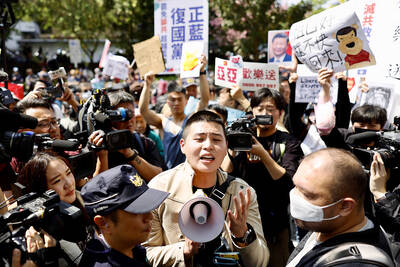For the past four months, Chinese hackers have persistently attacked the New York Times, infiltrating its computer systems and getting passwords for its reporters and other employees.
After surreptitiously tracking the intruders to study their movements and help erect better defenses to block them, the Times and computer security experts have expelled the attackers and kept them from breaking back in.
The timing of the attacks coincided with the report of a Times investigation, published online on Oct. 25, that found that the relatives of Chinese Premier Wen Jiabao (溫家寶) had accumulated a fortune worth several billion of US dollars through business dealings.
Security experts hired by the Times to detect and block the computer attacks gathered digital evidence that Chinese hackers, using methods that some consultants have associated with the Chinese military in the past, breached the Times’ network.
They broke into the e-mail accounts of its Shanghai bureau chief, David Barboza, who wrote the reports on Wen’s relatives, and Jim Yardley, the Times’ South Asia bureau chief in India, who previously worked as bureau chief in Beijing.
“Computer security experts found no evidence that sensitive e-mails or files from the reporting of our articles about the Wen family were accessed, downloaded or copied,” Times executive editor Jill Abramson said.
The hackers tried to cloak the source of the attacks on the Times by first penetrating computers at US universities and routing the attacks through them, said computer security experts at Mandiant, the company hired by the Times. This matches the subterfuge used in many other attacks that Mandiant has tracked to China.
The attackers first installed malicious software, or malware, that enabled them to gain entry to any computer on the Times’ network. The malware was identified by computer security experts as a specific strain associated with computer attacks originating in China. More evidence of the source, experts said, is that the attacks started from the same university computers used by the Chinese military to attack US military contractors in the past.
Security experts found evidence that the hackers stole the corporate passwords of every Times employee and used those to gain access to the computers of 53 employees, most of them outside the Times’ newsroom.
Experts found no evidence that the intruders used the passwords to seek information that was not related to the reporting on the Wen family.
No customer data was stolen from the Times, they said.
Asked about evidence that indicated the hacking originated in China, China’s Ministry of National Defense on Wednesday said that “to accuse the Chinese military of launching cyberattacks without solid proof is unprofessional and baseless.”
In Beijing, Chinese Ministry of Foreign Affairs spokesman Hong Lei (洪磊) told reporters: “The competent Chinese authorities have already issued a clear response to the groundless accusations made by the New York Times.”
Asked about cyberspying and hacking accusations made against China in general, he said: “To arbitrarily assert and to conclude without hard evidence that China participated in such hacking attacks is totally irresponsible.”
“China is also a victim of hacking attacks. Chinese laws clearly forbid hacking attacks, and we hope relevant parties takes a responsible attitude on this issue,” he said.
Additional reporting by AFP

ENDEAVOR MANTA: The ship is programmed to automatically return to its designated home port and would self-destruct if seized by another party The Endeavor Manta, Taiwan’s first military-specification uncrewed surface vehicle (USV) tailor-made to operate in the Taiwan Strait in a bid to bolster the nation’s asymmetric combat capabilities made its first appearance at Kaohsiung’s Singda Harbor yesterday. Taking inspiration from Ukraine’s navy, which is using USVs to force Russia’s Black Sea fleet to take shelter within its own ports, CSBC Taiwan (台灣國際造船) established a research and development unit on USVs last year, CSBC chairman Huang Cheng-hung (黃正弘) said. With the exception of the satellite guidance system and the outboard motors — which were purchased from foreign companies that were not affiliated with Chinese-funded

PERMIT REVOKED: The influencer at a news conference said the National Immigration Agency was infringing on human rights and persecuting Chinese spouses Chinese influencer “Yaya in Taiwan” (亞亞在台灣) yesterday evening voluntarily left Taiwan, despite saying yesterday morning that she had “no intention” of leaving after her residence permit was revoked over her comments on Taiwan being “unified” with China by military force. The Ministry of the Interior yesterday had said that it could forcibly deport the influencer at midnight, but was considering taking a more flexible approach and beginning procedures this morning. The influencer, whose given name is Liu Zhenya (劉振亞), departed on a 8:45pm flight from Taipei International Airport (Songshan airport) to Fuzhou, China. Liu held a news conference at the airport at 7pm,

AIR SUPPORT: The Ministry of National Defense thanked the US for the delivery, adding that it was an indicator of the White House’s commitment to the Taiwan Relations Act Deputy Minister of National Defense Po Horng-huei (柏鴻輝) and Representative to the US Alexander Yui on Friday attended a delivery ceremony for the first of Taiwan’s long-awaited 66 F-16C/D Block 70 jets at a Lockheed Martin Corp factory in Greenville, South Carolina. “We are so proud to be the global home of the F-16 and to support Taiwan’s air defense capabilities,” US Representative William Timmons wrote on X, alongside a photograph of Taiwanese and US officials at the event. The F-16C/D Block 70 jets Taiwan ordered have the same capabilities as aircraft that had been upgraded to F-16Vs. The batch of Lockheed Martin

GRIDLOCK: The National Fire Agency’s Special Search and Rescue team is on standby to travel to the countries to help out with the rescue effort A powerful earthquake rocked Myanmar and neighboring Thailand yesterday, killing at least three people in Bangkok and burying dozens when a high-rise building under construction collapsed. Footage shared on social media from Myanmar’s second-largest city showed widespread destruction, raising fears that many were trapped under the rubble or killed. The magnitude 7.7 earthquake, with an epicenter near Mandalay in Myanmar, struck at midday and was followed by a strong magnitude 6.4 aftershock. The extent of death, injury and destruction — especially in Myanmar, which is embroiled in a civil war and where information is tightly controlled at the best of times —